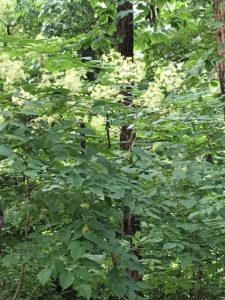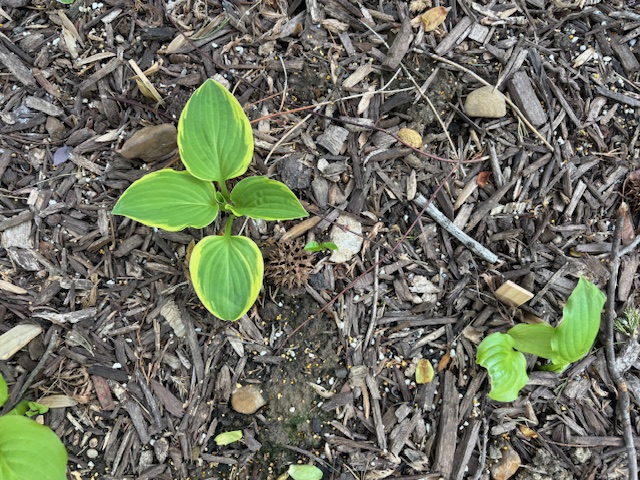Devil’s Walking Stick
Views: 6720

When we first bought our property, it was an impenetrable jungle of autumn olives, floribunda roses and honeysuckle vines. In order for us to even set foot on it, we had to ask the sellers’ permission to bring in a weed-eater and hack out a few paths. No kidding!
As we were able to clean up and de-tangle the mess, we realized that there were some very nice trees. Tulip poplar, sycamore, sweet gum (ask me about the gum balls, some day), black tupelo, sassafras, shellbark hickory and several varieties of oak. Still, there was a lot of what can only be described as Junk plants to clear out.
I knew very little about native plants then, so it’s understandable that I mistook an interesting native plant for an invasive weed. The plant was evil-looking! It was just a bare stalk with BIG, nasty looking thorns circling the stem at each growth scar. There were more thorns at the petioles; then an umbrella of intricate compound leaves. Judging by its looks, I concluded it was something that should be cut down…so I did.
Then, I found another – and cut that down; and another and another. By that time, I’d sort of run out of stalks that weren’t knee-high in poison ivy, so I gave it up for the day and then forgot about them.
Fast forward a year or two; I developed some knowledge of native plants and a nice library of reference books. One rainy evening, I was leafing through a field guide (can you say “Geek”?). There was a photo of the Evil Thorny Whatchamacallit and I realized that I had been cutting down Aralia spinosa (otherwise known as Devil’s Walking Stick, Hercules’ Club or Angelica Tree).
Where does it come from?
Apparently, Victorian gardeners used Angelica Tree (doesn’t that sound so much better than “Devil’s Walking Stick?) as an ornamental. Well, there’s something for everyone, I guess. Actually, at our place, it grows in the wilder parts which we’ve left for critter habitat, so they can grow all they like. But if you’re going to plant one on purpose, plant it away from paths and sidewalks, those thorns will shred you.
While it’s a great characteristic when growing out in the woods, it aggressively spreads by rhizomes. It’s not fun to get pierced by a thorn while you’re trying to pull up a sucker. Plant it where you don’t mind it spreading. It’s definitely showier planted in groups, so if you have the room, let them grow.
It can grow 20 feet tall, but at our place, the tallest is about 10 feet. It has white blooms in umbels at the top and the pollinators love them. The blackish fruits (technically “drupes”) are loved by birds, too. Amazingly, it’s a favored browse for white-tailed deer. Those deer must have really tough mouths!
The compound leaves have a beautiful pattern to them and look a bit tropical. I enjoy them from a distance and let the critters enjoy them up close.
By the way, I didn’t kill the ones I cut down…they simply put up two thorny stalks in place of the one I cut.
Meet Dona Bergman
Dona Bergman is a founding member, Southwest Indiana Chapter of the Indiana Native Plant & Wildlife Society, and an Advanced Master Gardener.







